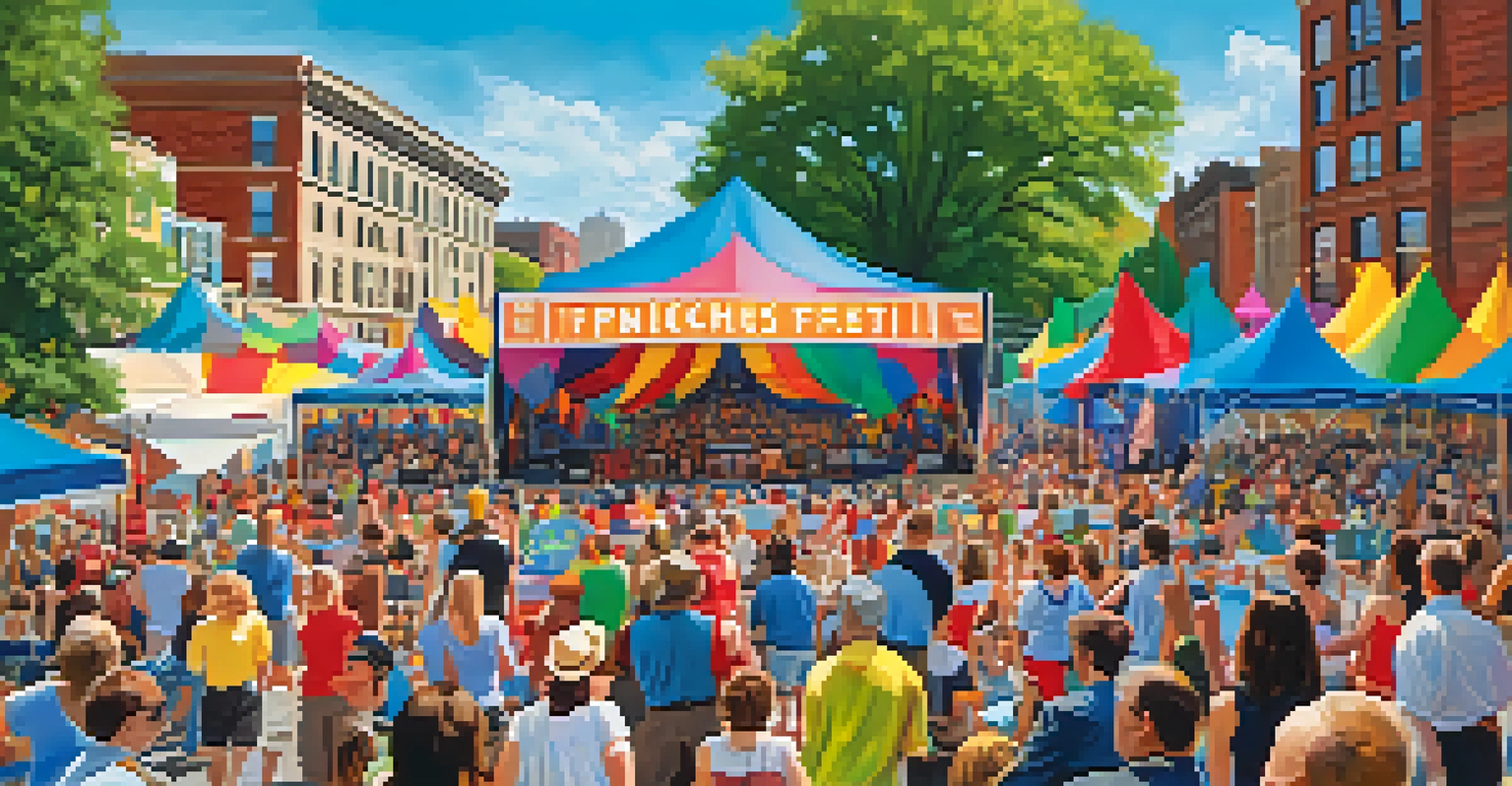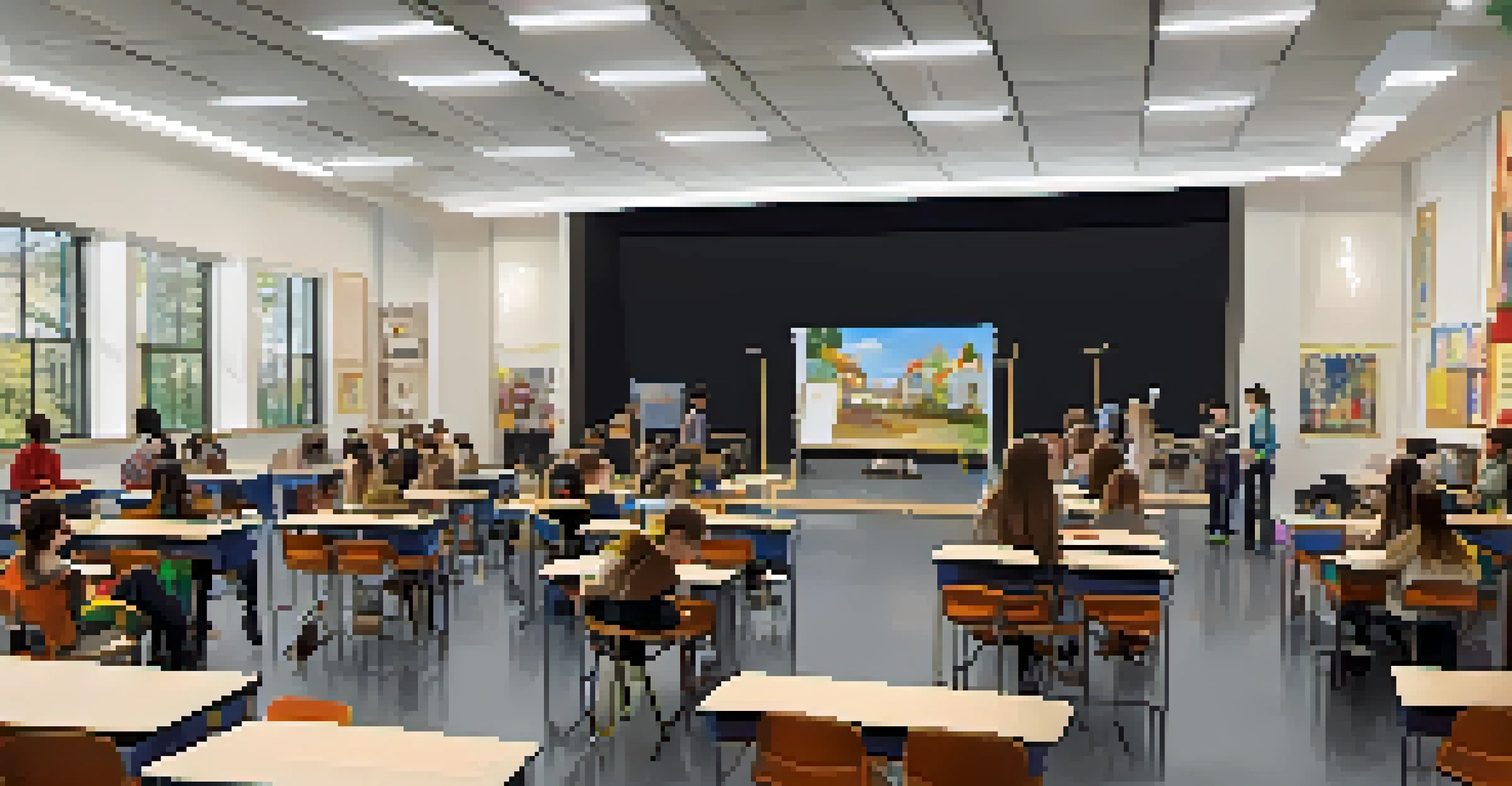The Evolution of Rochester's Theater Scene and Its Impact

A Glimpse into Rochester's Theatrical Beginnings
Rochester's theater scene dates back to the early 19th century, when local groups began staging performances in makeshift venues. The first significant theater, the Lyceum Theatre, opened its doors in 1857, showcasing a variety of productions that reflected the community's interests and values. This early establishment laid the groundwork for a rich cultural tapestry that would flourish in the decades to come.
Theater is the most immediate way to share with another human being the experience of being a human being.
As the city grew, so did the appetite for entertainment, leading to the establishment of more formal theaters. The Grand Opera House, built in 1880, became a central hub for performances, attracting renowned artists and drawing in audiences from surrounding areas. This venue not only enriched the local arts scene but also highlighted Rochester's emerging identity as a cultural center in New York State.
The initial stages of Rochester's theater evolution set the stage for a dynamic arts community. The blend of amateur and professional talent created an environment ripe for innovation and creativity. This foundation allowed for the experimentation with various theatrical styles, paving the way for future generations of performers and playwrights.
The Golden Age of Theater in Rochester
The early to mid-20th century marked a golden age for Rochester's theater scene, with the rise of vaudeville and the establishment of iconic venues. The Auditorium Theatre, opened in 1928, quickly became a landmark, hosting everything from Broadway shows to concerts. This era saw an influx of talent, as both local and national artists took the stage, contributing to the city's vibrant cultural landscape.

During this time, the arts were an integral part of Rochester's community identity. The theater served as a gathering place for people of all backgrounds, fostering a sense of belonging and shared experience. This communal aspect of theater helped to solidify its importance in the fabric of Rochester life.
Rochester's Rich Theater History
Rochester's theater scene, rooted in the early 19th century, has evolved to become a vital part of the city's cultural identity.
As the city embraced the performing arts, it also encouraged local playwrights and directors to experiment with new ideas. The result was a flourishing creative scene that not only entertained but also challenged societal norms and encouraged dialogue on pressing issues of the time. This commitment to artistic exploration further deepened the impact of theater in Rochester.
Rochester's Response to Changing Times
The late 20th century brought significant changes to Rochester's theater landscape, primarily due to economic shifts and evolving audience preferences. The rise of television and film led to a decline in attendance at live performances, prompting theaters to rethink their strategies. In response, many venues began to diversify their offerings, incorporating a wider range of genres and styles to attract broader audiences.
Art is the most beautiful of all lies; it is the most truthful of all truths.
This period also saw the emergence of community theaters that provided a platform for local talent and fostered grassroots creativity. Organizations like the Rochester Community Players and Geva Theatre Center became pillars of the community, emphasizing accessibility and inclusivity in the arts. These groups not only enriched the local arts scene but also encouraged diverse voices to be heard.
As Rochester adapted to these changes, it reaffirmed its commitment to supporting the arts. The city invested in arts education and outreach programs, ensuring that the theater remained a vital part of the community. This adaptability allowed Rochester's theater scene to thrive, even in the face of challenges.
The Rise of Diverse Voices in Theater
In recent years, Rochester's theater scene has made significant strides in promoting diversity and inclusion. Local organizations have actively sought to showcase works by artists from various backgrounds, reflecting the city’s rich cultural tapestry. This shift has opened doors for underrepresented communities and provided a platform for their stories to be told.
Initiatives such as the Rochester Fringe Festival have further amplified this focus on diversity, presenting a wide array of performances that challenge traditional narratives. By prioritizing inclusivity, the festival has become a celebrated event that attracts audiences from all walks of life, fostering a sense of unity through the arts. This festival serves as a testament to the community's commitment to celebrating diverse perspectives.
Diversity Shapes Modern Performances
Recent initiatives have embraced diverse voices in theater, fostering inclusivity and amplifying underrepresented stories.
The embrace of diverse voices not only enriches the theater experience but also sparks important conversations about social issues. By engaging with stories that resonate across cultures and experiences, Rochester's theater scene continues to evolve, reflecting the dynamic nature of its community.
The Impact of Rochester's Theater on Community Identity
The theater scene in Rochester has played a crucial role in shaping the city's identity over the years. Through storytelling and performance, local theaters have highlighted the unique experiences and challenges faced by the community. This connection between theater and identity fosters a sense of pride among residents, creating a shared narrative that binds them together.
Moreover, theater has served as a catalyst for community engagement, encouraging individuals to come together for a common purpose. Events like community theater productions and workshops allow residents to collaborate and contribute to the local arts scene, strengthening their ties to one another. These collaborative efforts have led to a more vibrant and interconnected community.
As Rochester continues to evolve, the theater remains a vital element of its cultural identity. By celebrating local stories and embracing diverse perspectives, the theater scene fosters a sense of belonging and encourages residents to take pride in their city's rich artistic legacy.
The Role of Education in Shaping Future Performers
Education plays a pivotal role in nurturing the next generation of performers and theater enthusiasts in Rochester. Local schools and universities have integrated arts programs into their curricula, allowing students to explore their creative potential from a young age. These educational initiatives not only cultivate talent but also instill a love for the performing arts that lasts a lifetime.
The collaboration between educational institutions and local theaters has created a thriving ecosystem for aspiring artists. Workshops, internships, and mentorship opportunities provide students with hands-on experience and exposure to the industry. This practical approach ensures that young performers are well-prepared to navigate the challenges of a competitive field.
Education Fuels Future Artists
Local educational programs play a crucial role in nurturing the next generation of performers and ensuring the longevity of Rochester's arts scene.
As the theater scene continues to evolve, the emphasis on education remains crucial. By investing in the arts and promoting access to theater education, Rochester is paving the way for a vibrant future filled with creativity and innovation in the performing arts.
Looking Ahead: The Future of Rochester's Theater Scene
As Rochester's theater scene continues to evolve, the future looks promising, thanks to its rich history and commitment to innovation. Local theaters are increasingly exploring new technologies and mediums to enhance the audience experience, making performances more immersive and engaging. This willingness to adapt and experiment will undoubtedly attract new audiences and keep the arts relevant in a rapidly changing world.
Collaboration among local theaters, artists, and community organizations is also expected to play a significant role in shaping the future. By working together, these entities can amplify their impact and create a more cohesive arts community. This collaborative spirit will ensure that Rochester remains a vibrant hub for creativity and expression.

Ultimately, the evolution of Rochester's theater scene reflects the resilience and adaptability of its community. As it embraces new ideas and diverse voices, the theater will continue to be a vital part of Rochester's cultural identity, enriching the lives of its residents for generations to come.